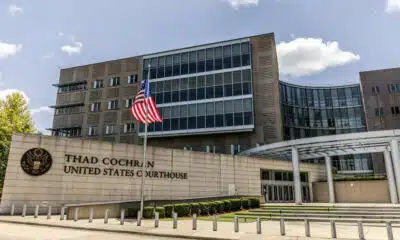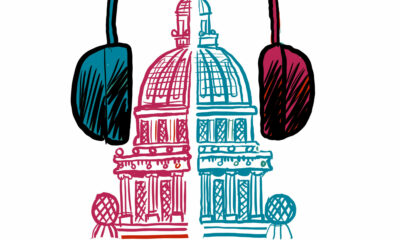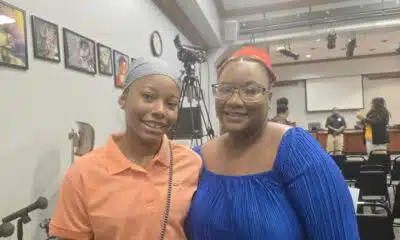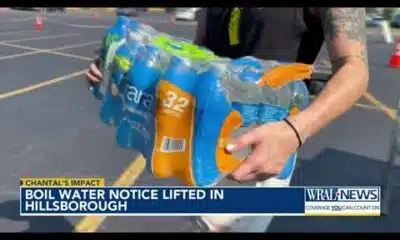Mississippi News
Data Dive: Mississippi’s TANF Work Program expenditures 2015-2022
Data Dive: Mississippi’s TANF Work Program expenditures 2015-2022
Editor’s Note: Public reports regarding the state’s administration of the Temporary Assistance for Needy Families program give little detail as to how Mississippi uses the $86.5 million in federal grant funds it is allocated each year. To provide a deeper look at the spending, Mississippi Today pulled and analyzed all expenditures from 2015-2022 labeled “TANF Work Program” from the state’s public accounting database, called MAGIC, available through the state’s Transparency website. The news organization also analyzed all federal financial reports for the program from 2015-2020.
There are several caveats to the data, but as lawmakers and policy experts research ways to improve this program’s operations, Mississippi Today is releasing the entirety of the data for the public’s use. If you have any questions or comments about the data, please email Anna Wolfe at awolfe@mississippitoday.org. For a downloadable PDF version of this report, click here.
Attempts by officials to quantify the misspending within the “Mississippi welfare scandal” appear in two main reports.
But the purchases they examined make up just a fraction of the state’s total welfare spending — leaving millions in spending a mystery to the public.
The state auditor’s 2019 Single Audit found misspending of $98 million in funds from the Mississippi Department of Human Services — the bulk of which were funds from the federal Temporary Assistance for Needy Families (TANF) program, but also included other federal grants: Supplemental Nutrition Assistance Program (SNAP), Child Care Development Funds (CCDF) and Social Services Block Grant (SSBG). The 2019 Single Audit is an annual report that examined spending in just that one year but extended into previous years in some cases, such as if the grant was a multi-year agreement.
MDHS commissioned a separate forensic audit that covered four calendar years, 2016-2019, and examined TANF spending exclusively. That report found misspending of $77 million. In the four fiscal years 2016-2020, Mississippi spent $317 million in federal TANF dollars.
In both cases, auditors questioned payments for multiple reasons — because the purchases didn’t comply with federal grant regulations, they constituted a conflict of interest or simply because they didn’t contain supporting documentation.
The primary difference in findings between the two reports comes from the fact the state Single Audit reviewed more grant spending than just TANF, and that the forensic audit attempted to comprehensively cover a four-year period. Other documents that help quantify the scandal include the initial indictments against six individuals in 2020, which alleged the theft of $4.15 million, and the civil suit MDHS is bringing against 38 individuals or companies, which alleges the defendants improperly received roughly $24 million.
Almost all of the identified DHS and TANF misspending occurred through subgrants that MDHS issued to outside organizations.
MDHS says it is addressing this by strengthening its internal controls and subgrantee monitoring. In late 2019 after the auditor’s investigation began, MDHS reinstituted a “Request for Proposals (RFP)” process for awarding TANF subgrants — a process the agency had not used since 2012, according to public records retrieved by Mississippi Today. The stricter rules have resulted in far fewer TANF dollars going out to service providers across the state.
The TANF program, a federal block grant to states, is best known for providing cash assistance — referred to as the “welfare check” — to very poor families. But the program gives states broad flexibility to spend the money in the ways they think will reduce or prevent poverty. Federal law does not require these the state to spend the money on evidence-based programs or to achieve specific desired outcomes. Across the country, states spend 80% of the money on things other than direct aid, on programs they call workforce training, child care, child welfare, out-of-wedlock pregnancy prevention and fatherhood. Most of these services are provided by organizations who vie for TANF subgrants to do the work.
But these grants do not make up the entirety of the TANF program in Mississippi.
The federal government allocates $86.5 million in federal TANF funds to Mississippi each year.
Unspent funds may roll over to the next year. In any given year, the state may be spending federal funds from previous grant years. The state must also put up a state match. Historically, the state has reported its college scholarship program as the bulk of its TANF state match.
From 2015 to 2022, Mississippi pushed about $156 million to subgrantees under the TANF Work Program, according to a Mississippi Today review of public expenditures, but that’s less than 40% of the roughly $418 million in federal TANF funds the state reported spending during those years. Just $36.5 million, less than 9%, went to cash assistance, per federal reports. So where did the rest go?
Using data from the state’s public accounting database, Mississippi Today found that between 2015 and 2022, MDHS spent more than $40 million on “Contractual Services” labeled under the “TANF Work Program.” This spending rose dramatically during the time of the corruption, from $162,077 in 2015 to $6.4 million in 2016 and $8.4 million in 2017. The agency has since quelled this spending since the scandal broke, reducing contractual services to $1.6 million in 2022.
Mississippi Today analyzed all expenditures labeled “TANF Work Program” under “Functional Area” in the state’s public accounting database, MAGIC, available through the state’s Transparency website, in state fiscal years 2015 to 2022.
Payments made under TANF subgrants — the subject of ongoing criminal investigations — are labeled under “TANF Work Program” and are reflected in the following figures.
There are some caveats to the data. Mississippi Department of Human Services told Mississippi Today that not all purchases made with federal TANF funds, such as cash assistance payments, are labeled this way and not all are retrievable through the state’s public accounting database. Additionally, some limited other grants are “charged” to the TANF Work Program, MDHS said, so these expenditures could reflect other grant spending. For these reasons, the agency said it would be impossible to compile an accounting of federal TANF funds using publicly facing data.
Sept. 19, 2022 email from MDHS: 6.) Generally, how can I match up the funding categories in the ACF reports with expenditures from the state? You can't. Federal reporting requires cost collection fields from MAGIC that are not available in Transparency.
At the bottom of this report is Mississippi Today’s full list of questions to MDHS and the agency’s answers. While recognizing imperfections with the data, Mississippi Today compared the TANF expenditures available in the public database to the TANF expenditures Mississippi reported in financial reports to the U.S. Department of Health and Human Services’ Administration for Children and Families (ACF) as a rough overview. State and federal fiscal years differ by about three months, so annual totals are not a perfect comparison. Additionally, the federal reports are typically behind by two years, so the most recent available federal ACF report is for the year 2020. Mississippi reported the highest expenditures of TANF funds on record in 2018, during the height of the welfare scandal.
Mississippi spent anywhere from $17 million (2020) to $52 million (2018) each year under TANF subgrants to outside organizations, according to Mississippi Today’s analysis of expenditures labeled under the “expense items” called “Grantor Payments Nontaxable” and “Transfer to Subgrantee” in MAGIC.
This spending is the primary subject of state audits and independent forensic audits conducted in the last two years. Mississippi Today’s analysis of MAGIC data shows Mississippi paid the two “Families First for Mississippi” nonprofits at the center of the scandal, Mississippi Community Education Center and Family Resource Center of North Mississippi, $55.8 million and $41.4 million in TANF funds, respectively, from 2015 to 2020. The two nonprofits did not receive any TANF funds in 2021 or 2022. Because of missing documentation, auditors say there are still roughly $40 million in purchases from MCEC that have not be examined.
The nonprofits are listed as “Vendors” in MAGIC. TANF subgrantees aren’t the only vendors who receive payments labeled “TANF Work Program” under “Functional Area” in the state expenditure database. Other governmental divisions, consulting firms, tech companies, accountants, a law firm and hotels are also some of the vendors that receive payments labeled “TANF Work Program.”
After MCEC and FRC, the next 20 highest paid “Vendors” for expenditures labeled “TANF Work Program” from 2015-2022 were Mississippi Alliance of Boys & Girls Club ($29.5 million), SPAHRS Payroll & Travel ($21.7 million), Jobs Bank Account ($7 million), Mississippi State University – MAFES ($6.1 million), Department of Employment Security ($5.8 million), Cambria Solutions Inc. ($5.2 million), Institutions of Higher Learning ($5 million), University of Mississippi-Accounting Office ($4.9 million), Midtown Partners ($3.8 million), Community College Board ($3.7 million), Mississippi State University ($3.7 million), Mississippi Children’s Home Society ($3.5 million), YMCA Association Metro Jackson ($2.8 million), Mississippi State University ($2.8 million), Three Rivers Planning & Development District ($2.8 million), Save the Children Federation ($2.6 million), Jobs for Mississippi Graduates ($2.4 million), Heart of David Ministry ($2.1 million), Mississippi State University ($2 million), Boys & Girls Club of Central Mississippi ($2 million). Some vendors, like Mississippi State University, have several vendor profiles in the state’s accounting database, which is why they may appear multiple times.
Payments of $62,727 to Pigott Law Firm, the private firm MDHS hired to bring the civil suit against people who improperly received welfare funds, were labeled under “TANF Work Program” in 2022.
The Office of the State Auditor also received payments labeled under “TANF Work Program” in 2018 ($137,568.67), 2019 ($276,997.26), 2020 ($420,692.81), 2021 ($420,692.81) and 2022 ($394,184.70). The office did not receive any of these payments from 2015-2017.
According to the ACF spending reports Mississippi sent to the federal government, the state spent a total of $104.4 million in federal TANF funds in 2018 and $55.1 million in 2020.
Comparing total spending to the subgrantee payments, the state spent $52 million in 2018 and $38 million in 2020 on things other than subgrants to outside organizations.
The state spent $6.1 million and $3.7 million in those years on direct cash assistance to needy families.
The ACF spending reports includes payments labeled “Child Welfare Services” — $20.8 million in 2018 and $21.8 million in 2020. Mississippi Department of Human Services confirmed it has been using a large chunk of its TANF fund to supplement the budget of the Mississippi Department of Child Protection Services, the agency tasked with overseeing the state’s foster care system and investigating child abuse and neglect. The agency has not stated how these dollars are utilized at CPS — whether they are used on salaries for caseworkers, for example, or on contracts with family unification agencies.
MDHS says it is currently awarding subgrants of $34.5 million each TANF grant year, spending $4.1 million on cash assistance and transferring $30 million to child welfare, leaving about $18 million in additional available federal funds on the table.
While MDHS said it spent $62.3 million in TANF funds in 2022, expenditures in the public database only reflect expenditures labeled “TANF Work Program” totaling $21.9 million. It explained that the remainder, $40.4 million, reflects payments that are not retrievable through Transparency, such as the payments to child protection services. To explain what this additional spending would be, MDHS only gave the example of cash assistance payments — which they said total $4.1 million — and “work related expenses on behalf of our clients.” MDHS did not provide any more information about how it spends the money.
2015-2020 ACF and MAGIC comparison
In federal ACF spending reports from 2015 to 2020, Mississippi reported spending $418 million in federal TANF funds. For this analysis, Mississippi Today only looked at expenditures, excluding transfers of TANF funds to the Child Care Development Fund (CCDF) or Social Services Block Grant (SSBG), which have also varied greatly from year to year.
Of the $418 million, $115 million was reportedly spent on “Child Welfare Services” — likely reflecting the transfers to CPS. It does not appear these transfers are reflected in expenditures labeled “TANF Work Program” in MAGIC. Excluding the transfers to child welfare, Mississippi reported spending $303 million in federal TANF funds from 2012-2020. The state’s public accounting database only reflects TANF spending of $221 million, leaving around $80 million in TANF funds that cannot be identified in the state’s public accounting database.
MDHS told Mississippi Today that cash assistance payments to TANF clients are not available in the state’s public accounting database. Mississippi reported to ACF spending $36.5 million between 2015-2020 on basic cash assistance, leaving at least $45.5 million in additional TANF spending during those years a mystery to the public.
According to interviews, MDHS began offering $250-a-month transportation stipends to TANF clients in the mid-2000s, but this spending is not broken down or identifiable in either the ACF reports or on Transparency, according to MDHS. It’s unclear how much this service is offered today.
When Mississippi Today requested from MDHS in May 2020 all TANF expenditures for fiscal year 2020, the agency provided two spreadsheets with information from the state’s accounting database. The spreadsheet of payments to vendors are coded as “TANF Work Program” under “Functional Area” — similar to what is available on Transparency — and contained the same kinds of vendors analyzed here. A separate spreadsheet contained the “EPAY” data — “EBT – Family Assistance,” “Children Assistance,” and “Other Assistance” — that is not retrievable by pulling “TANF Work Program” expenditures on Transparency. For a roughly seven-month period, the total issued through EPAY was about $4 million. That included roughly $1.3 million labeled as transportation — “PAY TR TRANS”, “PAY TRANSPORT” and “TRANS NOT WORK.”
“Expense Type & Item” comparison 2015-2022
A comparison of the “Expense Type” and “Expense Item” of “TANF Work Program” expenditures in MAGIC from year to year shows a large variation in program operations.
From 2016-2020, the largest payments to subgrantees were labeled in the “Transfer to Subgrantee” category. Today, the state is recording the bulk of these payments not as “Transfer to Subgrantee” but as “Grantor Payments Nontaxable.” For the purpose of this analysis, Mississippi Today is combining and considering both “Transfer to Subgrantee” and “Grantor Payments Nontaxable” — which, according to Mississippi Today’s review, typically go to TANF subgrantee organizations — as TANF subgrant payments.
TANF subgrants recorded in MAGIC have declined from $52 million in 2018 to $15.7 million in 2022, which tracks with the state cutting funding to MCEC and FRC in 2020, as well as imposing stricter requirements on TANF subgrants. Similarly, the state isn’t spending as much on contractual services ($8 million in 2018 versus $1.6 million in 2022) or on travel ($367,767 in 2019 versus $15,864 in 2022).
Salaries and wages for the program, however, have increased significantly since the scandal occurred.
In 2016, when John Davis became director and began moving to privatize functions of the agency, such as the child support enforcement division, salaries under the TANF program decreased from $5.3 million in 2015 to $1 million in 2016. While there wasn’t an acknowledgement the agency was “privatizing” the welfare program, MDHS began relying more and more on employees of the private “Families First” nonprofits to perform agency functions. The nonprofits were hiring away former employees of MDHS, but officials like Davis treated the state agency and private nonprofits as one in the same. Since the scandal broke and Families First shuttered, salaries charged under TANF have increased from less than $1 million in 2019 to nearly $2.5 million in 2022.
MDHS explained that during the time of the scandal, "additional funding was available from another source" to pay for salaries associated with the TANF Work Program and that when that funding ended, the salaries were charged back to TANF.
Vendors under the TANF Work Program 2022
MDHS paid 81 vendors a total of $21.9 million under the "TANF Work Program" in 2022. From 2015-2022, MDHS paid nearly 400 different vendors. The table below includes all the vendors who received at least $1,000 under the “TANF Work Program" from 2015-2022.
Current TANF subgrantees
According to a spreadsheet MDHS provided Mississippi Today, the agency awarded $36.7 million worth of TANF subgrants for the 2021 grant year. The agency has not awarded grants for 2022, which has ended. Based on the dollar amount spent in each category, it appears MDHS is placing more priority on workforce development ($14.9 million) and after school programs ($13.7 million) than parenting initiatives ($8.1 million), which was the primary function of Families First for Mississippi.
There is not a public-facing repository of information or data regarding the efficacy or outcomes of these programs.
Below are the answers MDHS provided Mississippi Today regarding data retrieval from Transparency. For several of the questions, MDHS did not provide a response.
MS TODAY questions (italics) and answers (bold) provided by MDHS on Sept. 19, 2022:
I looked at every expenditure in MAGIC labeled “TANF” in the “Functional Area” category. Here are the total expenditures in MAGIC from 2015-2022: 2015 ($12,929,221.02), 2016 ($26,406,682.63), 2017 ($42,461,946.71), 2018 ($63,755,024.00), 2019 ($48,772,637.14), 2020 ($26,406,682.63), 2021 ($18,780,281.73), 2022 ($21,869,598.21).
The amounts in MAGIC are far lower than the amount of TANF we reported spending to the feds. I realize MAGIC uses state fiscal year and the ACF reports are probably by federal fiscal year, but that wouldn’t account for the drastic differences between the total amounts labeled TANF in MAGIC and the figures we report to the feds. ACF “Federal Funds – Total Expenditures” highlighted next to the MAGIC figures below:
2015: $12,929,221.02 ($46,124,884)
2016: $26,406,682.63 ($49,844,769)
2017: $42,461,946.71 ($83,633,112)
2018: $63,755,024.00 ($104,424,460)
2019: $48,772,637.14 ($79,221,691)
2020: $26,406,682.63 ($55,119,534)
The ACF reports are very outdated, which is why it’s been so hard to look at current spending in the last two years. When the scandal broke in early 2020, the most recent report was from 2018. But in all the expenditure reports/subgrantee data I’ve gathered from the agency over the years, I’ve never seen enough to add up to the totals we report to the feds.
I know we transfer a good bit from TANF to CPS every year, so I even accounted for that in my analysis, in case those inter-agency transfers don’t appear on MAGIC.
The figures below are the ACF “Total Expenditures” minus “Child Welfare” (which I’m guessing are the CPS transfers — although the amounts under “Child Welfare” in the ACF reports, ranging from $12m to $27m, are still less than what CPS recently told me they get from TANF every year):
2015: $29,277,558
2016: $33,777,260
2017: $70,774,040
2018: $83,666,783
2019: $52,133,231
2020: $33,363,256
Comparing the amount of federal TANF dollars (minus “child welfare”) we reported spending to the federal government and the amount of TANF expenditures available on MAGIC, the difference is still as much as $28 million in some years.
1.) How do TANF Expenditures appear on MAGIC?
TANF Expenditures are captured in MAGIC using a system assigned Grant Number.
2.) Are all purchases made with TANF funds labeled as TANF in "Functional Area"?
No. A functional area represents an organizational division within the agency, and not a grant.
3.) If not why?
TANF expenditures may be charged to other organizational divisions, and would not appear in the TANF Work Program Functional Area. For example; TANF Assistance payments are charged to the "Assistance Payments" functional area.
4.) And how would I be able to view TANF expenditures then?
The public view on the Transparency Web Site does not provide the Grant Number / Description therefore you will not be {able }to categorically identify TANF specific charges using Transparency.
5.) If a purchase is labeled TANF under "Functional Area" does that mean it was funded with TANF funds?
No, there are other Grants that are charged to this functional area. For example, Sexual Risk Avoidance Grant charges appear under this functional area also.
6.) Generally, how can I match up the funding categories in the ACF reports with expenditures from the state?
You can't. Federal reporting requires cost collection fields from MAGIC that are not available in Transparency.
7.) How do TANF cash assistance payouts appear in MAGIC?
TANF Assistance payments are charged to the "Assistance Payments" functional area, using a Special Fund Type called a Bank Account Fund. Expenditures charged to this fund type are not available in Transparency.
8.) The most recent federal caseload data suggest we may be bulking up the cash assistance side of the program, but where is that reflected in agency spending/expenditure reports?
See answer to #7
9.) There is a category in MAGIC called "EBT-Family Assistance" but take a look at the totals in this category for each year:
2015: $0
2016: $0
2017: $0
2018: -$27,223
2019: -$121,654.16
2020: $0
2021: $0
2022: $1,955,000
a. Surely some people received cash assistance in these years, I hope, so why does this category in MAGIC appear so low?
If Transparency provided visibility of the Bank Account Fund type, then we would see assistance payments appear under this Commitment Item. (See also answer to #7) The "EBT-Family Assistance" Commitment Item is a category that we charge both SNAP and TANF assistance payments to. However, you are not seeing the payments, you are only seeing some relatively immaterial adjustments made through Journal Entries which are being charged to the MDHS Grant Fund.
b. What do these figures, especially the negative figures mean?
As stated above, you are not seeing the payments, you are only seeing some adjustments made through Journal Entries which appear in the Grant Fund.
c. Why did it jump so drastically in 2022?
The $1.9 million in 2022 were expenditures for the Pandemic Emergency Assistance Fund (PEAF), which was a new federal grant, and not a part of our normal payments to clients.
10.) What are the payments to the vendor JOBS BANK ACCOUNT?
The "Jobs Bank Account" is a checking account and is primarily used to pay work related expenses on behalf of our clients. We deposit funds into this account and then write checks to cover the work related expenses. It is also used as a clearing account to wire funds to the vendor who handles TANF Assistance Payments and TANF Work Programs.
11.) What are these Jobs Bank Account Payments, who gets them, and why did the amount vary so drastically between 2020, 2021 and 2022? The amount jumped from just $685.75 in 2021 to $2 million in 2022? What explains this?
See answer to question 9.a. and 9.c. The Pandemic Emergency Assistance Fund ($1.9M) payments moved through the JOBS BANK ACCOUNT, hence the increase for 2022.
12.) What is the "EBT-Family Assistance - 67090000" and "Children Assistance - 67055000" and why are the amounts so low? We spent just $80 on Children Assistance in 2022, compared to $1.4 million in 2015.
"EBT-Family Assistance - 67090000": See answer 9.a.
"Children Assistance - 67055000: See answer to 9.a.
The amounts for 2015 are payments to clients through the JOBS Bank Account using State Funds for transitional transportation. Typically this is paid for from TANF Federal dollars, but in 2015 State Funds were needed for the TANF Maintenance of Effort. It was necessary to move these funds to the JOBS Bank Account, from sources that didn't involve the Bank Account Fund, and these fund sources appear in Transparency.
13.) I don't see anything in MAGIC that appears to represent the $250 transportation vouchers that MDHS offers. Where are the transportation vouchers reflected in agency spending?
These expenditures are found in the Bank Account Fund, see answer #7.
14.) My next question is about the administrative side of TANF. In the expenses labeled "TANF" in MAGIC, the "Salaries & Fringe Benefits" category has changed drastically over the years - from $5 million in 2015 to less than $1 million in 2019 to now up to nearly $2.5 million in 2022. During the timeframe where there was a decrease in the use of TANF funds for Salaries & Fringe Benefits, additional funding was available from another source. When this funding ended some of the salaries migrated back to TANF.
a. What does this mean for the TANF program?
b. Who are these employees and what are they doing?
c. The amount of TANF going to payroll in 2022 has more than doubled since 2019, but is half the amount in 2015. What is the ideal size of the program staff?
15.) MDHS used to spend between $10,000 and $140,000 in TANF funds on equipment every year, but we haven't spent any on equipment in 2021 and 2022. Our TANF commodities and travel spending has similarly declined.
a. How was this spending quelled? What has been the effect on the agency or program?
b. Ideally should any TANF funds be used on hotels, food, office furniture, etc.?
c. We still spend some of the money this way. Is that allowed and under what circumstances?
16.) Contractual services, and especially professional fees, have declined significantly as well. Did current MDHS leadership find these contracts unnecessary? Or were they moved to a different division in the agency?
17.) "Transfer to Subgrantee" vs. "Grantor Payments Nontaxable" The Department of Finance and Administration required that the agency change the General Ledger Accounting Codes used when making payments to our subgrantees resulting in the expenditures appearing under different Commitment Items.
18.) I assume we're spending a lot less on subgrants because of what happened, but how does the agency plan to rectify this moving forward so that the money is being pushed out to valuable services across the state?
Should be answered by the program
19.) Who are the following vendors and/or what are they doing for the TANF program
Mississippi Children's Home Society ($2.8 million)
Institutions of Higher Learning ($1.6 million)
Dept. of Employment Security ($677,000)
Community College Board ($500,000)
Guidesoft Inc. ($348,000)
Strategic Solutions for Families ($145,000)
United Family Life Center ($83,000)
Rose of Sharon ($77,000)
SASSI Institute ($49,500) (I know this is the drug testing vendor, but I don't see it as a vendor in every year, so I'm curious about that. Also, I thought clients had to pay to get drug tested? Do taxpayers also pay for this?)
Georgia Department of Human Services ($24,700)
Deer Oaks EAP Services ($8,850) (This is the Division's share of the Employee Assistance Program, and is an employee benefit not a client assistance payment.)
Med Screens ($1,900)
Random small payments to various county boards of supervisors.
20.) Again, we spent just $21.9 million, according to MAGIC, in 2022 on the TANF program, which is a $86.5 million-a-year program. How is that possible?
The $21.9 million is understated, and the actual amount for State FY 2022 was $62.3M. See answers to questions 1-3 & 7 for an explanation of why these expenditures would not be showing up in Transparency under the TANF Work Program
21.) Generally, what does MDHS hope to see for the TANF program in the future? Mississippi has so much more federal money for this program than we're currently spending. How does the state plan to best utilize these funds moving forward?
22.) Also, recent caseload data shows there were 256 adult recipients on TANF in November 2021, then 1,809 in December 2021 (the month Mississippi offered $1,000 bonuses to TANF recipients), then 166 in January 2022. How did that happen? How were that many more applicants able to qualify (for a program with such strict eligibility) and why did they fall off the rolls so fast?
This article first appeared on Mississippi Today and is republished here under a Creative Commons license.
Mississippi News
Events happening this weekend in Mississippi: July 11-13
SUMMARY: From July 11-13, Mississippi offers a variety of events for all ages. In Jackson, enjoy the season finale of “Late Night with Rita Brent,” Disney’s The Lion King, Jr., and exhibitions at the Mississippi Children’s Museum. Pearl hosts the Mississippi Mud Monsters with fireworks and a Back 2 School Bash. Ridgeland features the Wildflower Field, Art Park, Renaissance Christmas in July sales, and a Fairy Garden Workshop. Natchez and Vicksburg offer farmers markets and local entertainment. Hattiesburg presents Po Boy Fest, Clue: The Musical, and outdoor movies. Activities include rodeos, ice cream tastings, run clubs, and community tennis events across the state.
The post Events happening this weekend in Mississippi: July 11-13 appeared first on www.wjtv.com
Mississippi News
Death toll from catastrophic Texas flooding passes 100
SUMMARY: Catastrophic flooding in Texas over the July Fourth weekend killed at least 104 people, including 28 children, mostly near Camp Mystic, a century-old girls’ summer camp in Kerr County. Search-and-rescue teams continue to search swollen rivers for dozens still missing; officials expect the death toll to rise as more rain threatens the saturated area. Many victims were swept from cabins by flash floods early Friday, some clinging to trees. Authorities will investigate warnings and evacuation delays, noting poor cellphone service hindered alerts. Despite warnings issued before the flood, some residents didn’t receive them. President Trump plans to visit the state.
The post Death toll from catastrophic Texas flooding passes 100 appeared first on www.wjtv.com
Mississippi News
LIVE: Officials give updates on Texas floods
SUMMARY: Crews in central Texas continue searching for victims after catastrophic July Fourth weekend flooding killed over 80 people, including 27 campers and counselors at Camp Mystic along the Guadalupe River. The floods, some of the worst in decades, struck overnight, sweeping away tents and cabins. With more rain forecast, authorities warn the death toll may rise as many remain missing. Survivors described clinging to trees or fleeing to attics. Officials face scrutiny over flood warnings and emergency response. President Trump declared Kerr County a disaster area, pledging support while criticizing FEMA’s performance.
The post LIVE: Officials give updates on Texas floods appeared first on www.wjtv.com
-
News from the South - Tennessee News Feed2 days ago
Bread sold at Walmart, Kroger stores in TN, KY recalled over undeclared tree nut
-
News from the South - North Carolina News Feed6 days ago
Boil water notice lifted in Hillsborough
-
Mississippi Today5 days ago
Hospitals see danger in Medicaid spending cuts
-
News from the South - Arkansas News Feed7 days ago
Arkansas Department of Education creates searchable child care provider database
-
News from the South - Texas News Feed5 days ago
Why Kerr County balked on a new flood warning system
-
News from the South - Texas News Feed6 days ago
Sheriff hints at ‘after action’ review, as records reveal warning of ‘worst-case flood event’
-
News from the South - Arkansas News Feed7 days ago
Arkansas National Guard deployed to Texas to assist in flooding response
-
Our Mississippi Home7 days ago
MDMR-USM Hatchery Training Program Enters Production Phase with Oyster Spawning and Mobile Unit Launch

















































